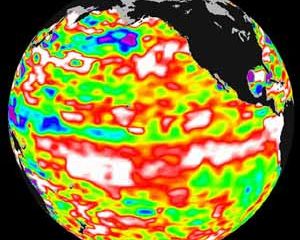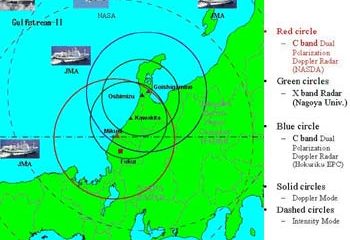
When 29-year-old Eric Lange suddenly experienced several hours of mental confusion last July, physicians at Cedars-Sinai Medical Center naturally ordered brain scans and carotid artery studies in their first search for a cause. With the initial exams turning out OK, Eric’s neurologist pursued other clues and ended up finding a heart defect called a patent foramen ovale, or PFO. A blood clot was believed to have slipped through the defect and out of the normal route of circulation that would

NASA sponsored scientists have discovered by knowing the salt content of the ocean’s surface, they may be able to improve the ability to predict El Nino events. Scientists, studying the western Pacific Ocean, find regional changes in the saltiness of surface ocean water correspond to changes in upper ocean heat content in the months preceding an El Nino event. Knowing the distribution of surface salinity may help predict events.
Salinity and temperature combine to dictate the ocean’s dens

NASA and two Japanese government agencies are collaborating on a snowfall study over Wakasa Bay, Japan. Using NASA’s Earth Observing System Aqua satellite, research aircraft and coastal radars to gather data, the joint effort is expanding scientific knowledge about where precipitation falls.
Until now, the north Pacific’s contributions to the global hydrologic cycle have been difficult to quantify. Precipitation measurements by satellite over open water are very important, because

Advanced magnetic resonance imaging (MRI) technology can detect heart attack in emergency room patients with chest pain more accurately and faster than traditional methods, according to a new study supported by the National Heart, Lung, and Blood Institute (NHLBI). Published in the February 4 issue of Circulation: Journal of the American Heart Association, the findings suggest that more patients who are suffering a heart attack or who otherwise have severe blockages in their coronary arteries could r

A Penn State researcher has developed a faster method for more efficient sharing of widely distributed Internet resources such as Web services, databases and high performance computers.
Jonghun Park, assistant professor in Penn State’s School of Information Sciences and Technology (IST) who has proposed the protocol, says the new technology speeds up to 10 times faster the allocation of Internet resources.
“In the near future, the demand for collaborative Internet applications wi

White tea extract reveals anti-cancer, anti-aging properties
Scientists at University Hospitals of Cleveland and Case Western Reserve University have proven that ingredients in white tea are effective in boosting the immune function of skin cells and protecting them against the damaging effects of the sun. The discovery that white tea extract protects the skin from oxidative stress and immune cell damage adds another important element in the battle against skin cancer.
Elma

– new calculation confirms standard model of particle physics. Contribution of hadronic vacuum polarization determined with unprecedented accuracy. The magnetic moment of the muon is an important precision parameter for…
Technique may prevent formation of unwanted waves that siphon off needed energy. Heating plasma to the ultra-high temperatures needed for fusion reactions requires more than turning the dial on a…

An international team of astronomers, led by researchers from the Astronomical Observatory of the University of Warsaw, have identified a new class of cosmic X-ray sources. The findings have been…

How deubiquitinases USP53 and USP54 cleave long polyubiquitin chains and how the former is linked to liver disease in children. Deubiquitinases (DUBs) are enzymes used by cells to trim protein…

Conceptual blueprint to analyze experimental catalyst data. Machine learning (ML) models have recently become popular in the field of heterogeneous catalyst design. The inherent complexity of the interactions between catalyst…

Antibody that Neutralizes Inhibitory Factors Involved in Nerve Regeneration Leads to Enhanced Motor Function after Acute Spinal Cord Injury. Researchers at 13 clinics in Germany, Switzerland, the Czech Republic and…

How simulations help manufacturing of modern displays. Modern materials must be recyclable and sustainable. Consumer electronics is no exception, with organic light-emitting diodes (OLEDs) taking over modern televisions and portable…

“Neurons that fire together, wire together” describes the neural plasticity seen in human brains, but neurons grown in a dish don’t seem to follow these rules. Neurons that are cultured…

The quest for sustainable energy solutions has been a major focus of scientific research for decades. Solar energy, a clean and renewable source, has emerged as a promising alternative to…

With a processing speed a billion times faster than nature, chip-based laser neuron could help advance AI tasks such as pattern recognition and sequence prediction. Researchers have developed a laser-based…

New technology could remotely identify various types of plastics, offering a valuable tool for future monitoring and analysis of oceanic plastic pollution. Researchers have developed a new hyperspectral Raman imaging…

Artificial Intelligence (AI) has established a strong presence across industries, large and small. The “VoBaKI” research project has empowered small and medium-sized enterprises (SMEs) with an innovative tool to independently…